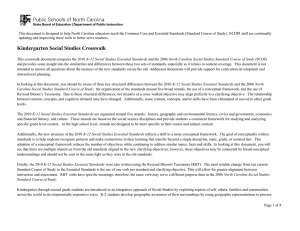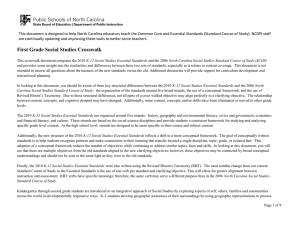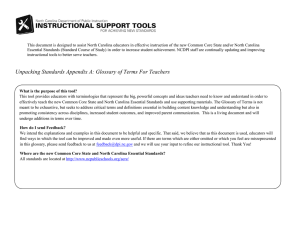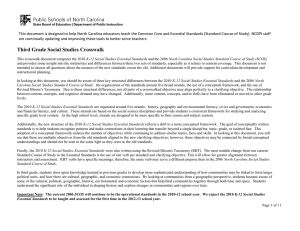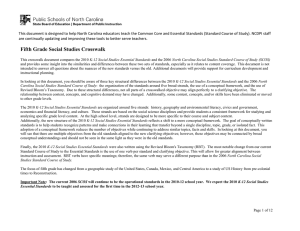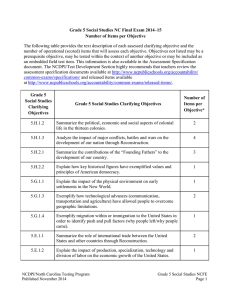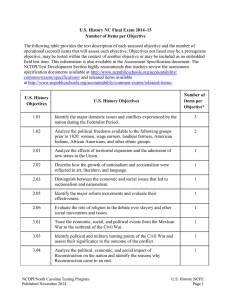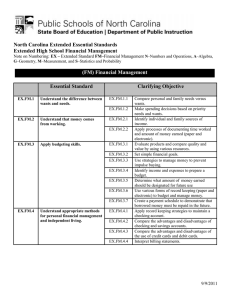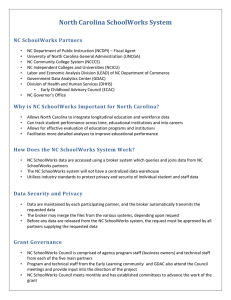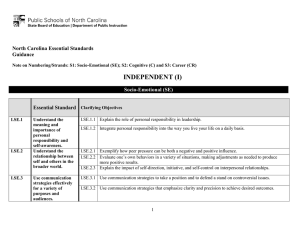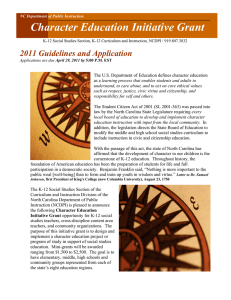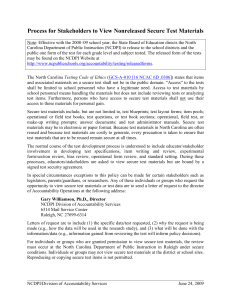This document is designed to help North Carolina educators teach...
advertisement
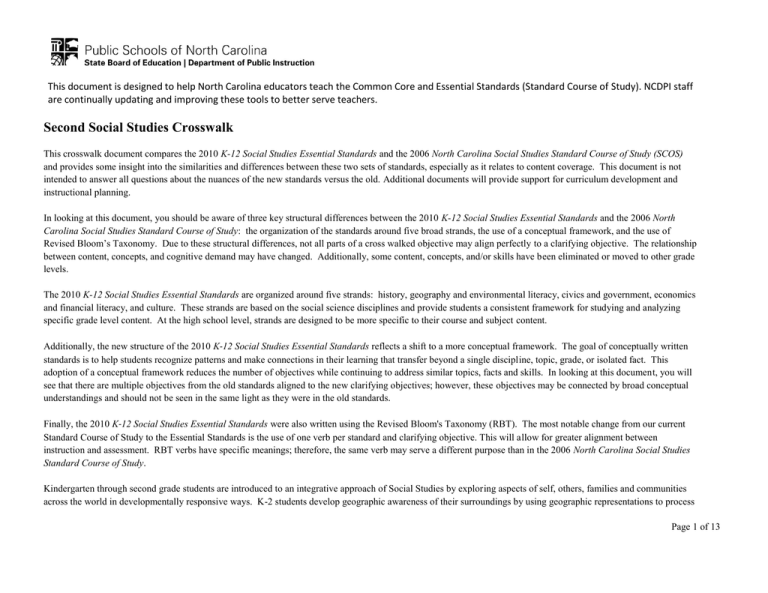
This document is designed to help North Carolina educators teach the Common Core and Essential Standards (Standard Course of Study). NCDPI staff are continually updating and improving these tools to better serve teachers. Second Social Studies Crosswalk This crosswalk document compares the 2010 K-12 Social Studies Essential Standards and the 2006 North Carolina Social Studies Standard Course of Study (SCOS) and provides some insight into the similarities and differences between these two sets of standards, especially as it relates to content coverage. This document is not intended to answer all questions about the nuances of the new standards versus the old. Additional documents will provide support for curriculum development and instructional planning. In looking at this document, you should be aware of three key structural differences between the 2010 K-12 Social Studies Essential Standards and the 2006 North Carolina Social Studies Standard Course of Study: the organization of the standards around five broad strands, the use of a conceptual framework, and the use of Revised Bloom’s Taxonomy. Due to these structural differences, not all parts of a cross walked objective may align perfectly to a clarifying objective. The relationship between content, concepts, and cognitive demand may have changed. Additionally, some content, concepts, and/or skills have been eliminated or moved to other grade levels. The 2010 K-12 Social Studies Essential Standards are organized around five strands: history, geography and environmental literacy, civics and government, economics and financial literacy, and culture. These strands are based on the social science disciplines and provide students a consistent framework for studying and analyzing specific grade level content. At the high school level, strands are designed to be more specific to their course and subject content. Additionally, the new structure of the 2010 K‐12 Social Studies Essential Standards reflects a shift to a more conceptual framework. The goal of conceptually written standards is to help students recognize patterns and make connections in their learning that transfer beyond a single discipline, topic, grade, or isolated fact. This adoption of a conceptual framework reduces the number of objectives while continuing to address similar topics, facts and skills. In looking at this document, you will see that there are multiple objectives from the old standards aligned to the new clarifying objectives; however, these objectives may be connected by broad conceptual understandings and should not be seen in the same light as they were in the old standards. Finally, the 2010 K‐12 Social Studies Essential Standards were also written using the Revised Bloom's Taxonomy (RBT). The most notable change from our current Standard Course of Study to the Essential Standards is the use of one verb per standard and clarifying objective. This will allow for greater alignment between instruction and assessment. RBT verbs have specific meanings; therefore, the same verb may serve a different purpose than in the 2006 North Carolina Social Studies Standard Course of Study. Kindergarten through second grade students are introduced to an integrative approach of Social Studies by exploring aspects of self, others, families and communities across the world in developmentally responsive ways. K-2 students develop geographic awareness of their surroundings by using geographic representations to process Page 1 of 13 This document is designed to help North Carolina educators teach the Common Core and Essential Standards (Standard Course of Study). NCDPI staff are continually updating and improving these tools to better serve teachers. information about locations using maps and globes. In history, students begin to develop the ability to think like a historian as they acquire knowledge of history to understand the past and present. In economics, students develop and build upon basic economic concepts by relating to their own needs and wants. Important Note: The current 2006 SCOS will continue to be the operational standards in the 2010-12 school year. We expect the 2010 K‐12 Social Studies Essential Standards to be taught and assessed for the first time in the 2012-13 school year. Strand 2010 Essential Standard 2006 NC Standard Course of Study Essential Standard Clarifying Objective Objective Comments History 2.H.1 Understand how various sources provide information about the past. 2.H.1.1 Use timelines to show sequencing of events. 2.H.1.2 Identify contributions of historical figures (community, state, nation and world) through various genres. 3.05Identify historical figures and events associated with various cultural traditions and holidays celebrated around the world. 3.06Identify individuals of diverse cultures and describe their contributions to society. Page 2 of 13 This document is designed to help North Carolina educators teach the Common Core and Essential Standards (Standard Course of Study). NCDPI staff are continually updating and improving these tools to better serve teachers. 2.H.1.3 Compare various interpretations of the same time period using evidence such as photographs and interviews. Page 3 of 13 This document is designed to help North Carolina educators teach the Common Core and Essential Standards (Standard Course of Study). NCDPI staff are continually updating and improving these tools to better serve teachers. Geography and Environmental Literacy Strand 2010 Essential Standard 2006 NC Standard Course of Study Essential Standard Clarifying Objective Objective Comments 2.G.1 Use geographic representations, terms and technology to process information from a spatial perspective. 2.G.1.1 Interpret maps of the school and community that contain symbols, legends and cardinal directions. 5.05Interpret maps, charts, and pictures of locations. 2.G.1.2 Interpret the meaning of symbols and the location of physical and human features on a map (cities, railroads, highways, countries, continents, oceans, etc.). 5.02Describe the role of a geographer and apply geographic tools, such as maps, globes, compasses and photographs, in the understanding of locations and characteristics of places and regions. Page 4 of 13 This document is designed to help North Carolina educators teach the Common Core and Essential Standards (Standard Course of Study). NCDPI staff are continually updating and improving these tools to better serve teachers. Geography and Environmental Literacy Strand 2010 Essential Standard 2006 NC Standard Course of Study Essential Standard Clarifying Objective Objective Comments 2.G.2 Understand the effects of humans interacting with their environment. 2.G.2.1 Give examples of ways in which people depend on the physical environment and natural resources to meet basic needs. Page 5 of 13 This document is designed to help North Carolina educators teach the Common Core and Essential Standards (Standard Course of Study). NCDPI staff are continually updating and improving these tools to better serve teachers. 2.G.2.2 Explain how people positively and negatively affect the environment. 6.01Identify natural resources and cite ways people conserve and replenish natural resources. 6.02 Cite ways people modify the physical environment to meet their needs and explain the consequences. Page 6 of 13 This document is designed to help North Carolina educators teach the Common Core and Essential Standards (Standard Course of Study). NCDPI staff are continually updating and improving these tools to better serve teachers. Strand 2010 Essential Standard 2006 NC Standard Course of Study Essential Standard Clarifying Objective Objective Comments Economics and Financial Literacy 2.E.1 Understand basic economic concepts. 2.E.1.1 Give examples of ways in which businesses in the community meet the needs and wants of consumers. 7.02Distinguish between goods produced and services provided in communities. 2.E.1.2 Explain the roles and impact producers and consumers have on the economy. 7.01Distinguish between producers and consumers and identify ways people are both producers and consumers. 2.E.1.3 Summarize the concept of supply and demand. 2.E.1.4 Explain why people and countries around the world trade for goods and services. 2.E.1.5 Explain how money is used for saving, spending, borrowing and giving. (1st Grade) 6.06Identify the uses of money by individuals which include saving and spending. Page 7 of 13 This document is designed to help North Carolina educators teach the Common Core and Essential Standards (Standard Course of Study). NCDPI staff are continually updating and improving these tools to better serve teachers. 2.E.1.6 Summarize the role of financial institutions relative to savings. Page 8 of 13 This document is designed to help North Carolina educators teach the Common Core and Essential Standards (Standard Course of Study). NCDPI staff are continually updating and improving these tools to better serve teachers. Strand 2010 Essential Standard 2006 NC Standard Course of Study Essential Standard Clarifying Objective Objective Comments Civics and Government 2.C&G.1 Understand the purpose of governments. 2.C&G.1.1 Explain government services and their value to the community (libraries, schools, parks, etc.). 2.C&G.1.2 Explain how governments establish order, provide security and create laws to manage conflict. 2.01Identify and explain the functions of local governmental bodies and elected officials. Page 9 of 13 This document is designed to help North Carolina educators teach the Common Core and Essential Standards (Standard Course of Study). NCDPI staff are continually updating and improving these tools to better serve teachers. Strand 2010 Essential Standard 2006 NC Standard Course of Study Essential Standard Clarifying Objective Objective Comments Civics and Government 2.C&G.2 Understand the roles and responsibilities of citizens. 2.C&G.2.1 Exemplify characteristics of good citizenship through historical figures and everyday citizens. 1.01Identify and describe attributes of responsible citizenship. 2.05Identify examples of responsible citizen participation in society and social environments. 2.C&G.2.2 Explain why it is important for citizens to participate in their community. 1.03Analyze and evaluate the effects of responsible citizenship in the school, community, and other social environments. Page 10 of 13 This document is designed to help North Carolina educators teach the Common Core and Essential Standards (Standard Course of Study). NCDPI staff are continually updating and improving these tools to better serve teachers. Strand 2010 Essential Standard 2006 NC Standard Course of Study Essential Standard Clarifying Objective Objective Comments Culture 2.C.1 Understand how various cultures influence communities. 2.C.1.1 Explain how artistic expressions of diverse cultures contribute to the community (stories, art, music, food, etc.). 3.06 Identify individuals of diverse cultures and describe on their contributions to society. 2.C.1.2 Recognize the key historical figures and events that are associated with various cultural traditions. 3.05 Identify historical figures and events associated with various cultural traditions and holidays celebrated around the world. 2.C.1.3 Exemplify respect and appropriate social skills needed for working with diverse groups. Eliminated/Moved Objectives: 1.02 Demonstrate responsible citizenship in the school, community, and other social environments. 1.04 Identify responsible courses of action in given situations and assess the consequences of irresponsible behavior. Page 11 of 13 This document is designed to help North Carolina educators teach the Common Core and Essential Standards (Standard Course of Study). NCDPI staff are continually updating and improving these tools to better serve teachers. 2.02 Recognize and demonstrate examples of the elective process. (moved to 3rd grade 3.C&G.2.3) 2.03 Describe the interdependence among individuals, families, and the community. 2.04 Evaluate the rules and laws and suggest appropriate consequences for noncompliance. 3.01 Compare similarities and differences between oneself and others. 3.02 Describe similarities and differences among families in different communities. 3.03 Compare similarities and differences among cultures in various communities. 3.04 Identify multiple roles performed by individuals in their families and communities. 4.01Analyze the effects of change in communities and predict future changes. 4.02 Analyze environmental issues, past and present, and determine their impact on different cultures. 4.03 Describe human movement in the establishment of settlement patterns such as rural, urban, and suburban. 5.01 Define geography and use geographic terms to describe landforms, bodies of water, weather, and climate. 5.03 Compare and contrast the physical features of communities and regions. 5.04 Identify the absolute and relative location of communities. (moved to 3rd grade 3.G.1.1) 5.06 Identify and describe the people, vegetation, and animal life specific to certain regions and describe their interdependence. 6.03 Identify means and methods of human movement as they relate to the physical environment. (moved to 3rd grade 3.G.1.4) 7.03 Describe different types of employment and ways people earn an income. 7.04 Identify the sources and use of revenue in the community. 7.05 Analyze the changing uses of a community’s economic resources and predict future changes. Page 12 of 13 This document is designed to help North Carolina educators teach the Common Core and Essential Standards (Standard Course of Study). NCDPI staff are continually updating and improving these tools to better serve teachers. 8.01 Identify uses of technology in communities. 8.02 Explain how technology has affected the world in which we live. 8.03 Interpret data on charts and graphs and make predictions. Page 13 of 13
